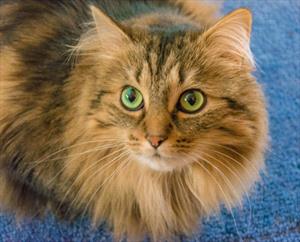cat staring

Triaditis is a condition in cats that involves three separate diseases: pancreatitis, cholangitis/cholangiohepatitis, and inflammatory bowel disease (IBD). Veterinary scientists are not sure why this happens to cats, especially because cats can have one disease, such as pancreatitis, without having the other diseases.
A bacterial infection in one or more of the associated organs (gastrointestinal/GI tract, pancreas, liver, gallbladder) or an autoimmune process is most likely what initiates the condition.
Many scientists suspect that triaditis probably starts with issues in the GI tract that result in IBD, such as an overproduction or imbalance of certain kinds of gut bacteria (known as intestinal dysbiosis) or GI inflammation associated with an abnormal immune reaction in the gut. This then leads to pancreatitis and cholangitis.
Pancreatitis is inflammation of the pancreas, an organ that produces enzymes to help break down food in the intestinal tract. It can develop suddenly as acute pancreatitis or be a long-term, chronic problem.
Cholangitis is inflammation of the gallbladder and bile ducts. When the liver is also inflamed, it is sometimes called cholangiohepatitis. The gallbladder makes bile, which helps break down fatty foods in the intestinal tract. The ducts or passageways for the pancreas and gallbladder open into the intestines in the same place, so when that area of the intestines is inflamed, infected, or diseased, the pancreas and gallbladder have a higher chance of being injured as well.
IBD is a chronic condition of the intestines in which inflammation leads to a poorly functioning GI tract. Causes are numerous and include overactivity by the immune system, food allergies, abnormal bacteria in the gut, and genetics. These causes often occur in some combination together.
How is Triaditis Diagnosed?
In cats with triaditis, the most common sign is vomiting or throwing up. Decreased activity levels, diarrhea or loose stool, poor appetite, and weight loss are also frequently seen. Occasionally, fever, tummy pain, a yellow tinge to the skin (known as icterus), and swelling of the belly may occur.
Your veterinarian will want to do a thorough physical examination to assess for other causes of these signs. They will also run tests on your cat’s blood, such as a complete blood count (CBC), chemistry panel, and pancreatic lipase immunoreactivity test. X-rays and an abdominal ultrasound may also be needed. If a bacterial infection is suspected, a culture and sensitivity may be run on fluid or tissues from the affected organs. These tests help point the veterinarian in the right direction for diagnosing triaditis. However, to get an official diagnosis, biopsies of the pancreas, intestines, gallbladder, and surrounding liver are needed. While this sounds like a lot of tests, keep in mind that triaditis is three different diseases happening at the same time, so it can be difficult to get the diagnosis right. Thank goodness kitties are so tough!
Treating Triaditis
In order to treat triaditis effectively, all three diseases need to be managed. Pancreatitis treatment may include pain medication, treatment for nausea, and hospitalization and fluid therapy for dehydration. Triaditis treatment is similar, although liver and gallbladder protective medications such as ursodiol, samE, or Denamarin may be used to help encourage healing. Antibiotics may be given if a bacterial infection is diagnosed. IBD treatment includes managing the cause of GI disease, which can involve a special diet, medications to suppress the immune system, and vitamin B supplementation when needed.
Additional treatments needed will depend on the complications or effects of triaditis on the pet. Bleeding disorders, gall stones (also known as choleliths), severe infections such as abscesses or septicemia, calcium deficiencies, and electrolyte imbalances are some of the complications that may occur, especially if treatment is delayed. For cats that won’t eat, feeding tubes are sometimes necessary.
Triaditis is a complex disease, but your veterinarian will be able to give you a good idea of what is needed for your cat and help you get them back to health. The prognosis can vary depending on the severity of the disease. Luckily, many cats with triaditis recover well with treatment. Unfortunately, the condition can return periodically. Be sure to monitor your cat at home for signs of recurrence and let your veterinarian know as soon as possible. The sooner treatment can be started, the more likely your pet will improve quickly.